Hope people don’t mind my inserting these comments before the primary article each week. I have no special arrangements with any of the companies, and I think I’m not much different that you in running across my share of companies that are good to do business with, and those that are a little less enjoyable of an experience.
Midway USA – I have a great set of close tolerance dies for the .338-378 from CH/4D that won’t overwork brass, or resize cases to unnecessarily small dimensions. But I wanted to have a set of tighter dies, so I could full length resize, and bring everything back to factory ammo specification, for use in critical hunting situations.
I like RCBS, but when they say an item is back ordered at the factory, that means you will not see that part, at least for all eternity, and maybe a little bit longer. I bought the Weatherby, based on the notion RCBS could deliver dies from stock. Didn’t happen. Then I received an RCBS delivery commitment for 6 – 8 weeks. Didn’t happen, and I was left with a “there is no delivery date” status. I also called every RCBS retailer and Internet operation I could think of, spending most of my time waiting for the laughter to die down, before I was told “Not in this life time”.
I was pointed to CH/4D, a company that had a variety of die sets in stock for the .338-378, and they shipped next day delivery after being nice enough to match a set of dies up to a fired cartridge from my rifle. The dies work fine and they are everything I would want in precision equipment. I’m sure they will outlast me and/or the rifle.
I received a copy of the Midway catalog in the mail and, while thumbing through it, I saw a listing for RCBS .338-378 dies. I didn’t believe it and didn’t even call for a week. Then I figured, with an 800 number, why not. The response was, “Item is in stock, can ship today, will be there before November 28th, and we pay surface freight. Would you like to donate to the NRA round up ?” So I said, “No, I think you misunderstood. I’m looking for..blah, blah..” She reaffirmed.
Not only did they have this relatively unique material in stock, but at a more than fair price, and it showed up eight days early. So I called back today and ordered every odd .338 bullet I hadn’t been able to locate elsewhere, bullet pulling collets, plastic strips for loading primers for my APS bench tool and all of the items I had not been able to secure for the past weeks. All in stock. Midway has been testing on-line ordering, and they are currently open till midnight for phone orders. Nice folks.
“Big” just keep getting bigger…………..
loads for the 7 mm RM and the .338-378 WM – Part III
By wpadmin
 In most of the current reloading handbooks, such as Hornady‘s 4th edition, or Speers Number 12, they reference measuring case head expansion as an accurate way of determining if handloads are generating normal or excessive chamber pressure. In general terms, case head expansion between .0003 and .0005 is typically the result of chamber pressures in the 50,000 psi range. This measurement applies to brass that has been used between one and three times only.
In most of the current reloading handbooks, such as Hornady‘s 4th edition, or Speers Number 12, they reference measuring case head expansion as an accurate way of determining if handloads are generating normal or excessive chamber pressure. In general terms, case head expansion between .0003 and .0005 is typically the result of chamber pressures in the 50,000 psi range. This measurement applies to brass that has been used between one and three times only.
There is some difference of opinion amongst authors as to where the exact point of measurement should be. So before using this method, I would suggest thoroughly researching the manuals mentioned, and reading through an article such as the one Kevin Pinkerton pointed me to, “Developing Pet Loads” by Ken Waters (1982). The text under the heading “Ken Waters’ method for judging pressure” goes into much greater detail, and offers many more practical examples than either manual, for using case expansion as a basis for estimating chamber pressure.
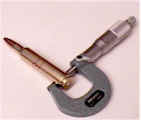 That horseshoe shape, wrapped around that cartridge case, is a micrometer. I know it’s strange looking, but that’s what they use to look like before they grew LCD’s and mechanical digital counters. I elected to use a standard outside micrometer, rather than a blade type. I felt the blade contact surface would invite inaccurate measurement, as a result of minor case surface irregularities. To further avoid these types of problems, I also make it my practice to index my measurement position to some point in the head stamp.
That horseshoe shape, wrapped around that cartridge case, is a micrometer. I know it’s strange looking, but that’s what they use to look like before they grew LCD’s and mechanical digital counters. I elected to use a standard outside micrometer, rather than a blade type. I felt the blade contact surface would invite inaccurate measurement, as a result of minor case surface irregularities. To further avoid these types of problems, I also make it my practice to index my measurement position to some point in the head stamp.
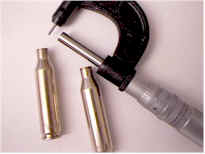 I think I will find a correlation between neck brass thickening, case head expansion and chamber pressure, which will be very much cartridge and rifle specific. I hope to eventually be able to use neck thickness as a second indicator, or perhaps qualifier, of case head expansion. If not, I will at least have an excuse for playing with a hole locator micrometer. If anything shakes out of this, I’ll put the results in a future article.
I think I will find a correlation between neck brass thickening, case head expansion and chamber pressure, which will be very much cartridge and rifle specific. I hope to eventually be able to use neck thickness as a second indicator, or perhaps qualifier, of case head expansion. If not, I will at least have an excuse for playing with a hole locator micrometer. If anything shakes out of this, I’ll put the results in a future article.
There are other signs to look for: flattened primers, internal ridges or rings forming inside the case about 1/4″ up from the bottom, bright spots on the case headstamp where the case began to flow into recesses in the bolt face. The bolt may become difficult to turn after firing the rifle, the case hard to extract, or you may sense excessive recoil. Unfortunately, by the time you get to most of these indicators, you may be well beyond safe chamber pressure. Measuring case head expansion seemed more early and valid detection to me, and worth the extra effort required to take measurements while developing new maximum loads.
 This is a little picture I like to call “California Sunshine”. After waiting for over a week, we took a chance on a break in the rain clouds to give us a few clear minutes. The black blob in the foreground is the Weatherby and the Pact console, further out in dark could shadows – the skyscreens without diffusers and, way the heck out there, where it’s just plain overcast, targets and the beginning of the 15 month California’s rainy season. Could be worse, I could be in Seattle.
This is a little picture I like to call “California Sunshine”. After waiting for over a week, we took a chance on a break in the rain clouds to give us a few clear minutes. The black blob in the foreground is the Weatherby and the Pact console, further out in dark could shadows – the skyscreens without diffusers and, way the heck out there, where it’s just plain overcast, targets and the beginning of the 15 month California’s rainy season. Could be worse, I could be in Seattle.
The oversize spacing of the Pact skyscreens permitted shooting at any bull, on a five bullseye target, without shooting the brackets. I know Pact put a ton of caution notes in their manuals to suggest conditions that might make the chronograph inconsistent or yield erroneous readings. Eight feet from the muzzle, with enough blast to shake the plastic parts like jelly, I never experienced one weird or missing reading. This has to be one of the easiest pieces of equipment to setup and operate. I do, however, think I was suffering from equipment overload, which is not unlike buck fever. I had two boxes full of equipment, three rifles, and God knows how many boxes of ammo, and I never felt so disorganized in my life. Fortunately, my wife was there to help me stay in focus, like one of those old TV sets you had to thump on every once in a while to stop the picture from rolling.
I mentioned in my last installment that the 7mm RM resizing die expander rod and plug assembly was broken and I was waiting for committed parts from RCBS. Well, a stuck case extractor arrived, depriming pins arrived, but the rod and plug were backordered. Latest update was that the parts physically left the factory and should be here soon. They have really good equipment, and probably one of the best integrated reloading systems, so I think I’ll just try being a little patient for a change.
I did have a chance to gather a portion of the preliminary data, and to uncover some problems with the process. The table below is the first data collection during this break in rain clouds. Measured velocity was taken with a Pact Chronograph. The screens were approximately 8′ from the muzzle and the temp was approximately 71F.
| Cartridge | Brand | Bullet Wt | Advertised Velocity fps |
Avg. Measured Velocity fps |
Variance |
| 7mm RM | Winchester | 150 | 3100 | 3031 | -69 |
| 7mm RM | Winchester | 175 | 2860 | 2833 | -27 |
| .243 | PMC | 80 | 2940 | 3116 | +176 |
| .243 | Reload | 80 | 3000 | 3041 | +41 |
| .338-378 | Weatherby | 250 | 3060 | 3026 | -34 |
| .338-378 | Reload1 | 250 | 3082 | 2972 | -90 |
 The 7mm RM data was acquired using a 700 BDL RemingtonMagnum with a 26″ barrel. I’m sorry I didn’t have other brands of ammo with me, as Winchester is probably not the best brand with this rifle. Unlike my shoulder, which has little appreciation for long term use of heavy bullet weights, the rifle does like 175 grain loads over 150’s. The 175’s on the left group around .900, the 150’s spread out to 1.400. Remington ammo usually shoots no more than .750″. In any case, I think I have my work cut out for me. I need to pick up almost 170 fps on the 150’s and almost the same on the 175’s.
The 7mm RM data was acquired using a 700 BDL RemingtonMagnum with a 26″ barrel. I’m sorry I didn’t have other brands of ammo with me, as Winchester is probably not the best brand with this rifle. Unlike my shoulder, which has little appreciation for long term use of heavy bullet weights, the rifle does like 175 grain loads over 150’s. The 175’s on the left group around .900, the 150’s spread out to 1.400. Remington ammo usually shoots no more than .750″. In any case, I think I have my work cut out for me. I need to pick up almost 170 fps on the 150’s and almost the same on the 175’s.
The .243 loads were inserted so I would have a second cartridge using IMR 7828 with magnum primers. I wanted to see if whatever characteristics this powder developed in the Weatherby, were also present in a more common round. IMR 7828 was a compressed load in the .243, so much so I wasn’t able to get to maximum pressure/velocity loads with this powder. The fact I use small base reloading dies with this cartridge, probably didn’t help the case capacity issue.
If you’re not familiar with these types of dies, they resize cases to a dimension slightly smaller than a standard full length resizing die. We use our .243 ammo in a Browning lever action rifle as well as a bolt action. A lever action, like pumps and auto loaders, doesn’t have the mechanical advantage of a bolt action, when chambering and extracting rounds. There would be a high probability that the lever action would jam on reloads that had been originally fired in the bolt action, if they had only been passed through a neck resizing die, or perhaps even a standard full length resizing die.
The actual load for the .243 was –
48 grains of IMR 7828
Federal 215 primers
80 grain Speer spitzers

Report was low, recoil was non-existent, the powder burned really clean, and accuracy was pretty good. The PMC factory ammo, while averaging around 100 fps above spec, burned black, really fouled the gun, and posted poor accuracy. The test data was obtained from a Remington 700 with a 24″ barrel.
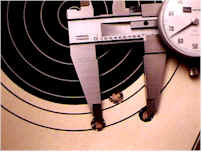 The factory .338-378 loads were consistently good performers, with a velocity standard deviation of less than 5. For all I’ve heard about Weatherby optimistic ballistics, their published data seems very credible and this round clearly smokes the .338 Winchester factory loads on performance.
The factory .338-378 loads were consistently good performers, with a velocity standard deviation of less than 5. For all I’ve heard about Weatherby optimistic ballistics, their published data seems very credible and this round clearly smokes the .338 Winchester factory loads on performance.
It’s nice to know I can go to any store and pick up a box of 250 grain ammo that will approach 3100 fps and group less than 1″. This is .9 with me rushing shots to wrap up, and without having a comfortable position at the bench. Of course my big toe was sore and I had on this really annoying shirt sleeve that kept bunching up, then……
Based on the IMR 7828 results with the .243, I thought the loads I started with for the .338-378 would be “light”, pressure would be low and I would have a lot more upward latitude for building up velocity. This proved not to be the case, but I am not really to suggest that 7828 was a problem powder with this cartridge.
The first reload I attempted to collect data on was –
103 grains of IMR 7828
Federal 215 primers
250 grain Speer Grand Slam
This was actually the low end, of a series of loads, that appeared in a credible data source.
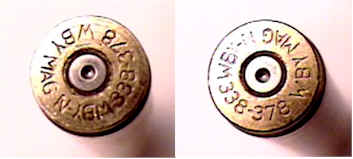 In this large case, IMR 7828 barely reached the base of the shoulder and velocity was really disappointing. I started at 103 grains and could go no further.
In this large case, IMR 7828 barely reached the base of the shoulder and velocity was really disappointing. I started at 103 grains and could go no further.
Case head expansion was .0008, which suggests excessive pressure, and the case head was pounded until there were radial lines from the bolt face and part of the character imprints were beginning to flatten. The fired factory case on the right shows no similar signs of excessive pressure.
I decided to move to the base loads of Reloader 25 and skip the rest of the IMR loads until I could spend a little more time on analyzing the problem, but I couldn’t chamber the first round I tried. In fact, the bolt wouldn’t come close enough to closing to even start rotation. Very odd, since I had cycled every one of the test rounds through the rifle before attempting to fire anything. I tried factory loads, and they cleared without a problem. Approximately 2/3 rd’s of the reloads cleared as well. Unknown cause of obstruction and rounds too tight to chamber ? We packed everything up and headed home without firing another shot.
When I got home I pulled the bolt and used a bore light to take a closer look at the throat just ahead of the chamber. There was an accumulation of jacket material to the right side of the throat. So I went back and looked at the bullets in the factory rounds and reloads. I found no marks on the factory cartridges, but definite marks on the bullets of the reloads that would not chamber. So I made the assumption that this small jacket buildup was enough to cause interference when attempting to chamber some of the reloads. At this point, I was probably more concerned with what caused the damage to the jacket and why cartridges loaded to factory length would find throat interference, while factory loads would clear.
 I took one of the fired cases, ran it through the sizing die, then inserted a Speer 250 grin bullet, seating the bullet out an additional .020″ from my earlier reloads. The bolt wouldn’t close. I pulled the round and noticed a deep gouge on the upper right side of the chamber position. Humm….
I took one of the fired cases, ran it through the sizing die, then inserted a Speer 250 grin bullet, seating the bullet out an additional .020″ from my earlier reloads. The bolt wouldn’t close. I pulled the round and noticed a deep gouge on the upper right side of the chamber position. Humm….
Two areas of potential problems came to light. I set up a dial indicator and checked bullets to see how straight the bullet was to the vertical axis of the case. Factory ammo had approximately a .004 runout at a point slightly beyond where the bullet projected from the case neck. Some of the reloads were out as much as .017, so I wasn’t consistently seating these bullets squarely. I assume the resulting early contact with the throat may have caused a jacket to partially shear, and copper build up creating an interference.
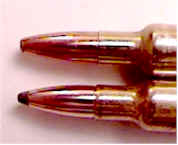 The second problem was a little more subtle, and based on the ogive design difference between the factory rounds and reloads. Evidence of throat interference with the bullet of the reload occurred at 3.130″, as measured from the base of the cartridge to a point on the bullet ogive.
The second problem was a little more subtle, and based on the ogive design difference between the factory rounds and reloads. Evidence of throat interference with the bullet of the reload occurred at 3.130″, as measured from the base of the cartridge to a point on the bullet ogive.
At this point on the cartridge, the Speer Grand Slam measured .333. At the same point on the Weatherby cartridge, the Nosler Partition bullet (factory load) measured only .321. I would only be able to reach that small of a diameter with the Speer bullet if I seated the bullets .100 deeper in the case. Obviously, not a practical solution as the crimp cannelure was already too low to serve a purpose. So what’s my conclusion ?
This is a problem I should have detected, with a very standard check, prior to reloading any cartridges. A dummy round should have been built up, and used to test bullet to rifling clearance. Generally, the planned overall cartridge length, with the specific bullet to be used, should have left a 1/32″ clearance at the throat between the bullet and the rifling.
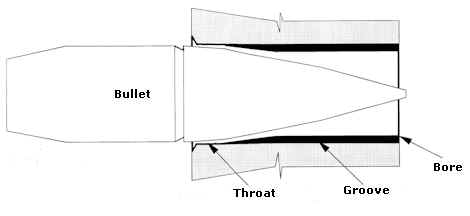
The process is actually very straight forward. A resized empty case, with no primer, is placed in the seating die. The seating plug is screwed down only enough to marginally seat the bullet. An attempt is then made to chamber the round, without forcing the bolt closed. This cycle is repeated until the bolt just barely closes without bring forced. Black marker can then be used to coat the bullet, and to check for contact with the rifling. At this point, it would probably be appropriate to back off one full turn on the seating plug. The goal is to have the bullet seated 1/32″ off the rifling.
Running this check is critical for this project, as one of the goals for these loads was increased muzzle velocity, and I intended to use relatively heavy powder charges. Parking a bullet on the rifling will cause serious pressure spikes, especially with anything other than minimum loads. While I did initially chamber test rounds, I was not as thorough the formal seating depth setting process would have been, and I didn’t take into account bullets not being seated perfectly aligned to the bore. This lack of concentricity and lack of freebore combined to exaggerate the problem of: rounds not chambering, signs of excessive pressure with very light powder loads and jacket damage at the bore throat.
The plan, at this time, is to backup and run a check of clearances and see if I can actually use the Speer bullet with this cartridge, and maybe find out why I am having a problem seating bullets squarely.
Right now, I have material on order that may slow the process by a week or so. If I get backed up and can’t complete the open items, we’ll see if we can cover a short topic next week and get back at this the week after.
Thanks
Joe

Email Notification